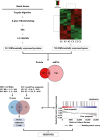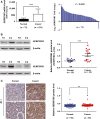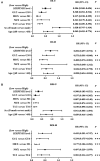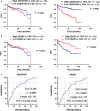SERPINH1 overexpression in clear cell renal cell carcinoma: association with poor clinical outcome and its potential as a novel prognostic marker
- PMID: 29239102
- PMCID: PMC5783852
- DOI: 10.1111/jcmm.13495
SERPINH1 overexpression in clear cell renal cell carcinoma: association with poor clinical outcome and its potential as a novel prognostic marker
Abstract
Precision therapy for clear cell renal cell carcinoma (ccRCC) requires molecular biomarkers ascertaining disease prognosis. In this study, we performed integrated proteomic and transcriptomic screening in all four tumour-node-metastasis stages of ccRCC and adjacent normal tissues (n = 18) to investigate differentially expressed genes. Most identified differentially expressed genes revealed a strong association with transforming growth factor-β level and the epithelial-to-mesenchymal transition process. Of them, Serpin peptidase inhibitor clade H member 1 (SERPINH1) revealed the strongest association with poor prognosis and regulation on the expression levels of epithelial-to-mesenchymal transition markers. Subsequently, two independent sets (n = 532 and 105) verified the high level of SERPINH1 in ccRCC tissues and its association with reduced overall survival and disease-free survival in all tumour-node-metastasis stages and patients with von Hippel-Lindau wild-type (VHL-WT). SERPINH1 was an independent predictor of poor overall survival (hazard ratio 0.696 for all patients) and disease-free survival (hazard ratio 0.433 for all patients and 0.362 for patients with VHL-WT) in ccRCC. We have thus shown for the first time that SERPINH1 is an independent precision predictor for unfavourable prognosis in ccRCC. This could assist in identifying patients who need early aggressive management and deepen our understanding of the pathogenesis of VHL-WT ccRCC.
Keywords: SERPINH1/HSP47; prognostic marker; proteomics; renal cancer; transcriptomics.
© 2017 The Authors. Journal of Cellular and Molecular Medicine published by John Wiley & Sons Ltd and Foundation for Cellular and Molecular Medicine.
Figures





Similar articles
-
Circular RNA circ-TNPO3 inhibits clear cell renal cell carcinoma metastasis by binding to IGF2BP2 and destabilizing SERPINH1 mRNA.Clin Transl Med. 2022 Jul;12(7):e994. doi: 10.1002/ctm2.994. Clin Transl Med. 2022. PMID: 35876041 Free PMC article.
-
VHL mutation-mediated SALL4 overexpression promotes tumorigenesis and vascularization of clear cell renal cell carcinoma via Akt/GSK-3β signaling.J Exp Clin Cancer Res. 2020 Jun 8;39(1):104. doi: 10.1186/s13046-020-01609-8. J Exp Clin Cancer Res. 2020. PMID: 32513235 Free PMC article.
-
Differential Expression of PD-L1 Between Sporadic and VHL-Associated Hereditary Clear-Cell Renal Cell Carcinoma and Its Correlation With Clinicopathological Features.Clin Genitourin Cancer. 2019 Apr;17(2):97-104.e1. doi: 10.1016/j.clgc.2018.11.001. Epub 2018 Nov 13. Clin Genitourin Cancer. 2019. PMID: 30522901
-
Genomic and proteomic approaches to renal cell carcinoma.J Nephrol. 2011 Mar-Apr;24(2):155-64. doi: 10.5301/jn.2010.90. J Nephrol. 2011. PMID: 20437403 Review.
-
Clear cell renal cell carcinoma with wild-type von Hippel-Lindau gene: a non-existent or new tumour entity?Histopathology. 2019 Jan;74(1):60-67. doi: 10.1111/his.13749. Histopathology. 2019. PMID: 30565303 Review.
Cited by
-
3'UTR-Seq analysis of chicken abdominal adipose tissue reveals widespread intron retention in 3'UTR and provides insight into molecular basis of feed efficiency.PLoS One. 2022 Jul 1;17(7):e0269534. doi: 10.1371/journal.pone.0269534. eCollection 2022. PLoS One. 2022. PMID: 35776773 Free PMC article.
-
Splicing factor derived circular RNA circCAMSAP1 accelerates nasopharyngeal carcinoma tumorigenesis via a SERPINH1/c-Myc positive feedback loop.Mol Cancer. 2022 Feb 28;21(1):62. doi: 10.1186/s12943-022-01502-2. Mol Cancer. 2022. PMID: 35227262 Free PMC article.
-
Differential expression analysis identifies a prognostically significant extracellular matrix-enriched gene signature in hyaluronan-positive clear cell renal cell carcinoma.Sci Rep. 2024 May 9;14(1):10626. doi: 10.1038/s41598-024-61426-3. Sci Rep. 2024. PMID: 38724670 Free PMC article.
-
Bottom up proteomics reveals novel differentiation proteins in neuroblastoma cells treated with 13-cis retinoic acid.J Proteomics. 2019 Oct 30;209:103491. doi: 10.1016/j.jprot.2019.103491. Epub 2019 Aug 28. J Proteomics. 2019. PMID: 31472280 Free PMC article.
-
Proteomic Technology "Lens" for Epithelial-Mesenchymal Transition Process Identification in Oncology.Anal Cell Pathol (Amst). 2019 Oct 29;2019:3565970. doi: 10.1155/2019/3565970. eCollection 2019. Anal Cell Pathol (Amst). 2019. PMID: 31781477 Free PMC article. Review.
References
-
- White NM, Yousef GM. Translating molecular signatures of renal cell carcinoma into clinical practice. J Urol. 2011; 186: 9–11. - PubMed
-
- Feldkoren B, Hutchinson R, Rapaport Y, et al Integrin signaling potentiates transforming growth factor‐beta 1 (TGF‐beta1) dependent down‐regulation of E‐Cadherin expression ‐ Important implications for epithelial to mesenchymal transition (EMT) in renal cell carcinoma. Exp Cell Res. 2017; 355: 57–66. - PubMed
-
- Haddad AQ, Luo JH, Krabbe LM, et al Prognostic value of tissue‐based biomarker signature in clear cell renal cell carcinoma. BJU Int. 2017; 119: 741–7. - PubMed
Publication types
MeSH terms
Substances
LinkOut - more resources
Full Text Sources
Other Literature Sources
Medical
Miscellaneous

